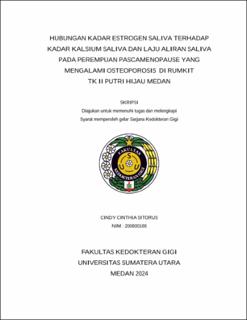Hubungan Kadar Estrogen Saliva terhadap Kadar Kalsium Saliva dan Laju Aliran Saliva Pada Perempuan Pascamenopause yang Mengalami Osteoporosis di RUMKIT TK II Putri Hijau Medan
The Relationship of Salivary Estrogen Levels to Salivary Calsium Levels and Salivary Flow Rate In Postmenopausal Women With Osteoporosis At TK II Putri Hijau Medan Hospital

Date
2024Author
Sitorus, Cindy Cinthia
Advisor(s)
Darwis, Aida Fadhilla
Metadata
Show full item recordAbstract
Decreased estrogen levels are a risk factor for bone disorders in postmenopausal women characterized by increased calcium levels in saliva and oral manifestations of decreased salivary flow rates. This study aims to see the relationship between salivary estrogen levels and salivary calcium levels and salivary flow rate in postmenopausal female patients. This research is analytical observational research with a cross sectional approach method which includes postmenopausal women aged 55-74 years and has been diagnosed with osteoporosis with a sample size of 52 subjects. Data collection in this study was carried out by measuring the flow rate of unstimulated saliva using the spitting method, then saliva samples were calculated for salivary estrogen levels by ELISA examination and salivary calcium by QuantiChromTM Calsium Assay Kit (DICA-500)® examination. Data were analyzed using Spearmen's Correlation Test. The results of this study showed that salivary estrogen levels of postmenopausal women who experienced osteoporosis were lower (0.008 ± 0.030 ng/ml) than normal levels, salivary calcium levels were higher (8.512 ± 3.741 μg/dl) than normal levels and there was a decrease in salivary flow rate with a mean (0.177 ± 0.064 ml/min). Based on the results of the correlation test between estrogen levels to salivary calcium levels and salivary flow rate, the significance value is 0.000 and it can be concluded that there is a negative correlation between salivary estrogen levels to salivary calcium levels and positive correlation between estrogen levels to salivary flow rate.
Collections
- Undergraduate Theses [1912]
